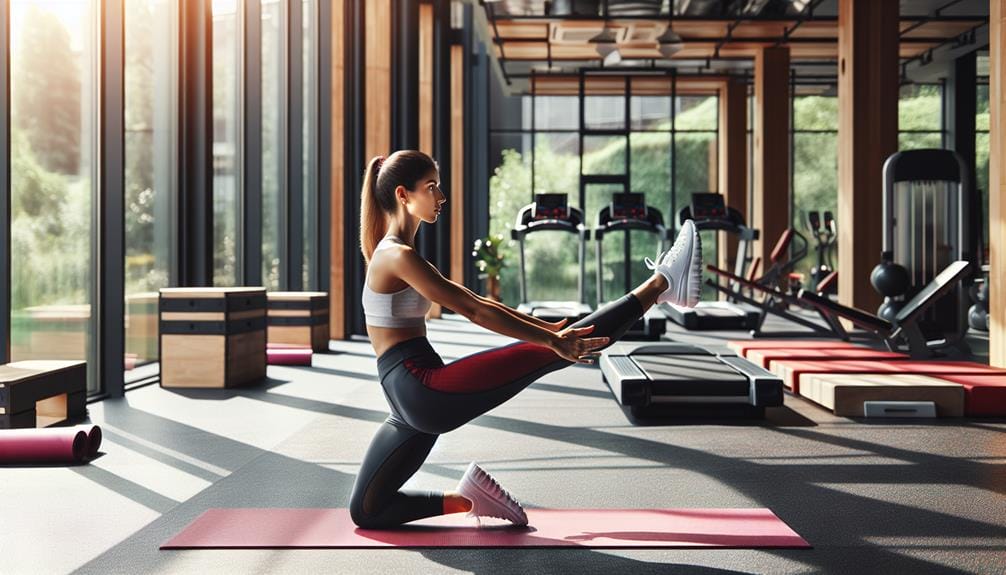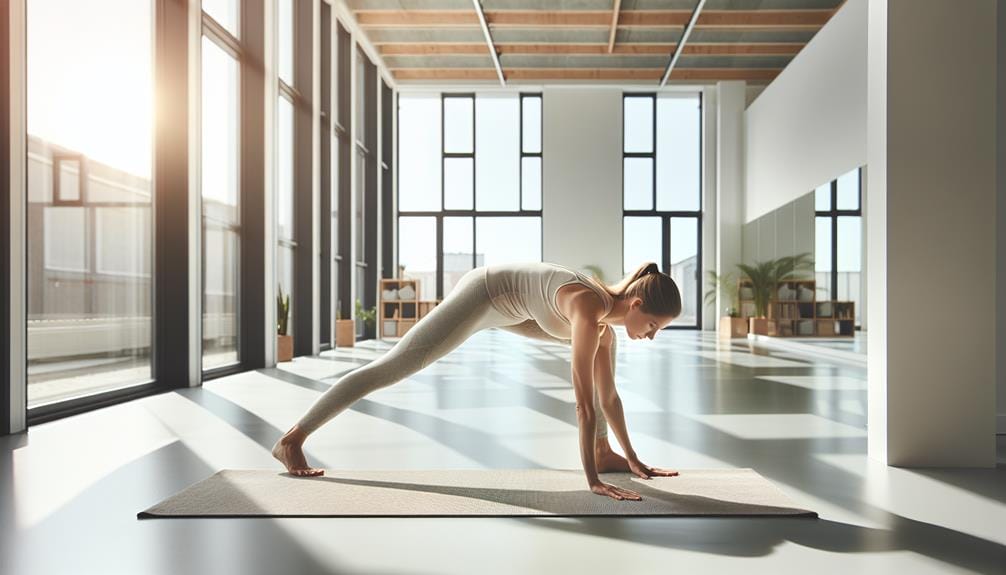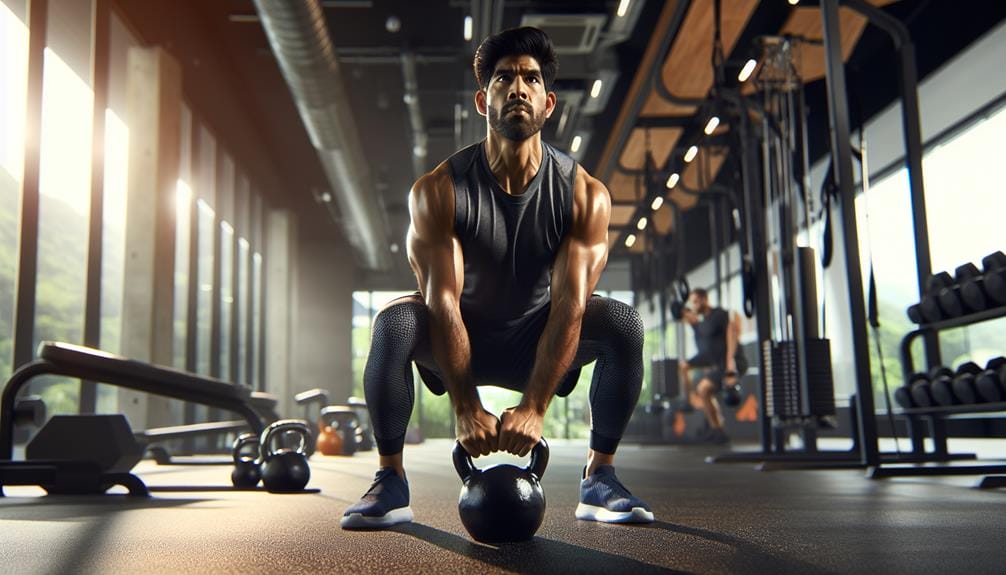For a stronger midsection, focus on effective core exercises like planks, which target your abs, obliques, and lower back. Incorporate variations such as side planks and forearm planks to challenge yourself. Russian twists enhance core stability, while bicycle crunches improve coordination. Leg raises work the lower abs, and hanging leg raises intensify the workout. Turkish get-ups boost overall strength and coordination, mimicking real-life movements. Kettlebell swings dynamically engage your core, and medicine ball slams build explosive power and stability. Each exercise contributes to a balanced and powerful core. For further details on these exercises and their benefits, keep going.
Key Takeaways
- Planks and their variations effectively target abs, obliques, and lower back for a stronger core.
- Russian Twists enhance core stability and strength when performed with proper form and challenging weights.
- Bicycle Crunches improve rectus abdominis and oblique strength, aiding in better stability and coordination.
- Hanging Leg Raises specifically target lower abs and hip flexors, boosting overall core strength and shoulder stability.
- Kettlebell Swings dynamically engage the core, providing a fun and effective way to enhance core stability and strength.
Plank
The plank is a foundational core exercise that frequently targets your abs, obliques, and lower back muscles. Imagine holding a perfect push-up position, but without the push-ups—that's the plank! It's your go-to move for rock-solid stability and superhero-level posture.
There are plenty of variations to keep things spicy, like the side plank, forearm plank, and high plank. Each one challenges your core muscles in unique ways. Want to level up? Adjust the duration and intensity of your hold.
Just remember, proper form is essential: keep that booty down and back straight to avoid any lower back drama. So, get planking, and soon you'll have abs that can deflect bullets (well, almost).
Russian Twist

When executing the Russian Twist, you'll want to maintain proper form to maximize benefits and prevent injury. Keep your back straight and your core engaged, twisting your torso without relying on momentum.
Common mistakes to avoid include hunching your shoulders, not engaging your core, and using too much weight too soon.
Proper Form Tips
To perform the Russian twist effectively, keep your back straight and core engaged to prevent lower back strain.
You're not auditioning for a hunchback role, so sit up tall! Twist from your torso, not just your arms, to really engage those obliques.
Use a weight that challenges you but lets you maintain proper form. Control the motion; we're not at a dance party, so no wild flailing!
Focus on breathing steadily and engage your core muscles to stabilize your body. Remember, you're sculpting those abs, not just swinging around.
Keep everything smooth and controlled, and you'll feel the burn right where you should. Now, go twist like you mean it!
Common Mistakes Avoid
Many people make the mistake of using momentum rather than controlled movements during the Russian twist, which reduces its effectiveness. Don't turn this core exercise into a wild dance move. Focus on controlled rotation to engage your core muscles.
Keep your spine straight—no hunchback impressions. Maintain proper form by keeping your chest up and shoulders back. Using a weight that's too heavy can lead to lower back strain.
Guarantee equal rotation to both sides to work your obliques evenly and prevent muscle imbalances. Remember, rushing through this exercise won't help; it's all about quality, not speed.
Bicycle Crunch
The bicycle crunch is a powerful exercise to target both your rectus abdominis and obliques. Imagine lying on your back, pedaling an invisible bike – it's like that, but way more effective for your core strength.
You twist, bringing your opposite elbow towards your knee while extending the other leg, engaging your abdominal muscles in a battle of endurance and sculpting. This move doesn't just work on those six-pack dreams; it also boosts your stability and coordination.
Incorporate the bicycle crunch into your routine, and you'll find your core strength skyrocketing. Plus, you'll never look at a bike the same way again, and your abs will thank you!
Leg Raise

When performing leg raises, prioritize maintaining proper form by keeping your lower back pressed into the floor and your core engaged throughout the movement.
Avoid common mistakes like arching your back or using momentum to lift your legs, as these can reduce the effectiveness of the exercise and increase the risk of injury.
To guarantee you're getting the most out of your leg raises, move slowly and control the descent of your legs.
Proper Form Tips
To maximize the benefits of leg raises, make sure to keep your lower back pressed into the ground to prevent strain and engage your core muscles effectively. Focus on core strength and stability by lifting your legs with control, targeting your lower abs and back muscles. Don't forget to engage your core throughout the movement. Performing leg raises with proper form guarantees you're hitting those deep core muscles. Gradually increase your range of motion as your strength improves. And remember, slow and steady wins the race—no swinging allowed!
Here's a quick guide to keep you on track:
| Key Point | What To Do | Why It Matters |
|---|---|---|
| Lower Back Position | Press into the ground | Prevent strain, engage core |
| Movement Speed | Slow and controlled | Target lower abs effectively |
| Breathing Technique | Exhale while lifting | Engage deep core muscles |
| Range of Motion | Increase gradually | Challenge muscles over time |
Common Mistakes Avoid
Many people make common mistakes during leg raises that can compromise their form and lead to injury. First, avoid swinging your legs like they're auditioning for a circus act. Focus on controlled movements to engage your core effectively. Keep your lower back pressed into the ground to prevent strain and make sure your abdominal muscles are doing the work.
Core engagement is key to maximizing benefits and preventing injury. Don't rush; gradual progression is your friend. Extend your legs fully or add ankle weights only when you've mastered proper form. Remember, it's not a race—slow and steady wins the six-pack!
Side Plank

A side plank is a powerful static core exercise that targets your obliques, transverse abdominis, and other stabilizing muscles. It's like a one-armed balancing act that also tests your patience and sanity! By balancing on one forearm and the side of your foot, you'll build core stability and improve your balance, all while strengthening those elusive lateral core muscles.
Looking to spice things up? Try adding hip dips or leg lifts for an extra challenge. Whether you're holding the position for 30 seconds or 60, you'll feel the burn. Beginners can drop the bottom knee for a bit of mercy.
Dead Bug
Lying on your back with arms and legs extended, the Dead Bug exercise is a fantastic way to target your core muscles effectively. This move zeroes in on your rectus abdominis and transverse abdominis. Not only does it strengthen your core, but it also boosts core stability, balance, and coordination. Plus, it's great for your lower back. To keep it interesting, you can modify the range of motion to match your fitness level. Stick to proper form, and you'll avoid straining your lower back. Here's a quick breakdown:
| Key Aspect | Benefit |
|---|---|
| Core Muscles | Strengthens |
| Core Stability | Enhances |
| Range of Motion | Adjustable for all levels |
Bird Dog

After mastering the Dead Bug, you can challenge your core further with the Bird Dog exercise. It's not about turning into a bird or a dog, but it's just as fun! This move targets your posterior core stability by engaging your lower back and glutes.
Start by extending one arm forward while simultaneously kicking the opposite leg backward. It's like trying to be graceful while balancing on a tightrope! The Bird Dog helps improve your balance, coordination, and overall core strength. Plus, it enhances spinal stability and reduces the risk of lower back pain.
Incorporate the Bird Dog into your routine to strengthen the muscles that support your spine and improve your posture. Get ready to impress your friends with your newfound stability!
Hollow Body Hold
Incorporate the Hollow Body Hold into your workout routine to engage multiple muscle groups and enhance core strength. This exercise might sound like a circus trick, but it's pure gold for your midsection. By lying on your back, lifting your legs and shoulders off the ground, and keeping a straight body position, you'll target the rectus abdominis, transverse abdominis, and obliques.
Here are three reasons to embrace this exercise:
- Endurance: It boosts your core endurance, making you less likely to tire out.
- Body Control: Helps you master body control, improving your overall athletic performance.
- Stability: A stable midsection means fewer wobbles in your workouts.
Give it a try—your core will thank you!
Hanging Leg Raise

Harness the power of the hanging leg raise to sculpt your lower abs and boost your core strength. This move is a game-changer for targeting your lower abs and hip flexors, giving you core strength and stability that's ready for anything.
You'll hang from a bar, lift your legs until they're parallel to the ground, and feel the burn.
Not only does it work your core muscles for enhanced abdominal strength, but it also challenges your grip strength and shoulder stability.
Want to up the ante? Add ankle weights or increase your range of motion for some serious progression.
Turkish Get-Up

The Turkish Get-Up is a powerful exercise that enhances your core strength, stability, and overall mobility.
To execute it correctly, you'll move from lying down to standing while keeping a weight overhead, which engages your core, shoulders, and legs.
Follow proper form guidelines to maximize benefits and reduce the risk of injury.
Benefits of Turkish Get-Up
A Turkish Get-Up offers a unique full-body workout that enhances core stability, mobility, and overall strength. By engaging multiple muscle groups, this exercise challenges your core muscles to work synergistically, making you stronger and more coordinated.
Plus, it's a functional exercise that mimics real-life movements, so you're basically training for the Olympics… of life.
Here are three benefits you'll get from incorporating Turkish Get-Ups into your routine:
- Core Strength: Your core stability will skyrocket as you balance yourself while holding a weight overhead.
- Overall Strength: This full-body exercise targets your shoulders, legs, and everything in between.
- Coordination: The series of movements improves your coordination, making you less likely to trip over your own feet.
Proper Form Guidelines
Mastering proper form in the Turkish Get-Up is essential to reap its full benefits and avoid potential injuries. As one of the best core exercises, this full-body exercise requires you to shift from lying down to standing while holding a weight overhead.
To maximize benefits and improve core strength, always engage your core muscles. Remember, this isn't a circus act; control and stability are key.
As a functional exercise, it mimics real-life movements, enhancing overall strength and mobility. Proper form means maintaining a straight wrist, keeping your arm locked out, and moving deliberately. This way, you'll prevent injury and truly harness the power of this movement.
Kettlebell Swing

When you perform a kettlebell swing, you're engaging your core muscles dynamically to build strength and stability. This powerhouse move targets your abdominals, obliques, and lower back, thanks to the hip hinge movement.
Your posterior chain gets a workout too, enhancing core stability and functional fitness. Plus, it's pretty fun to swing around a weight like you're in a medieval battle.
To master the kettlebell swing, remember:
- Form is King: Keep your back straight and hinge at the hips, not the waist.
- Engage the Core: Tighten those core muscles to protect your spine.
- Swing with Purpose: Use momentum from your hips, not your arms, to swing the kettlebell.
Get ready to swing your way to a rock-solid core!
Medicine Ball Slam
After mastering the kettlebell swing, you'll find the medicine ball slam to be another powerful exercise for building core strength and explosive power. Picture yourself lifting that weighted ball overhead and slamming it down like you're starring in your own action movie.
This full-body exercise targets your core muscles, specifically the rectus abdominis and obliques, while also engaging your shoulders, arms, and back. It's like the Swiss Army knife of workouts—versatile and incredibly effective.
Medicine ball slams improve power, strength, and coordination, enhancing your core stability and making you feel like a powerhouse. Incorporate this move into your routine, and you'll be well on your way to a stronger, more stable midsection.
Conclusion
Think of your core as the foundation of a sturdy house. Without a strong base, everything else wobbles.
By incorporating exercises like planks, Russian twists, and kettlebell swings, you're building that solid foundation brick by brick. This not only stabilizes your midsection but also enhances overall strength and balance.
Consistency is key in maintaining this stability. So, take these exercises seriously, and you'll see significant improvements in your core strength. Your body will thank you.









Leave a Comment